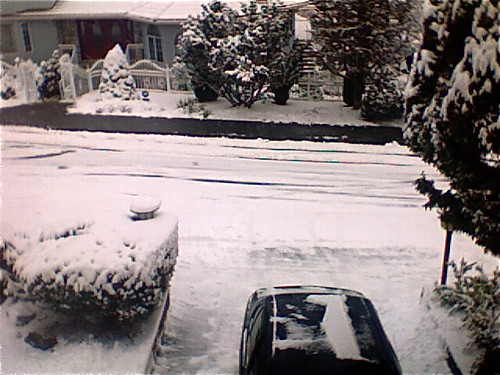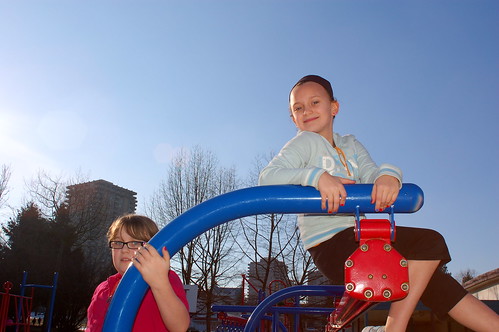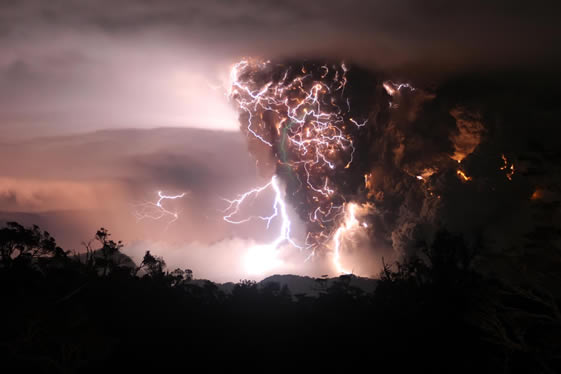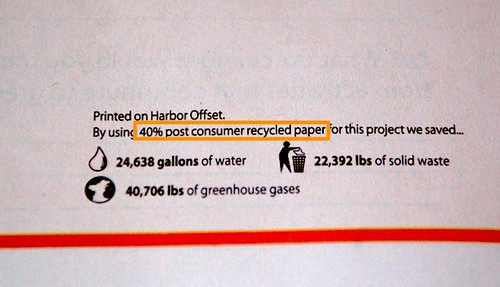Penmachine
15 April 2010
Sunny days at Camp Jubilee
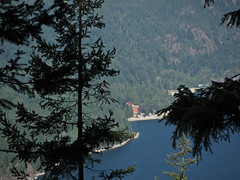 I can almost see the place where my daughter Marina slept last night, and will again tonight. But not quite. She and her school classmates in grades 6 and 7 are at Camp Jubilee for a two-night, three-day outdoor education adventure.
I can almost see the place where my daughter Marina slept last night, and will again tonight. But not quite. She and her school classmates in grades 6 and 7 are at Camp Jubilee for a two-night, three-day outdoor education adventure.
The camp sits near the tiny shoreline community of Frames Landing (which I'd never heard of until I looked it up just now) on the west shore of Indian Arm, the fjord whose mountain boundaries I can see from my front window. But those mountains are so steep and packed together that, though the camp is closer to our house than the ski slopes of Grouse Mountain that we can see clearly every day, it is entirely hidden behind several tree-coated ridges.
The only way to reach Camp Jubilee (or the homes at Frames Landing) is by boat. The camp has one to ferry visitors back and forth from Deep Cove, the urban harbour about 15 minutes to the south that is the easternmost part of North Vancouver. The kids have been incredibly lucky this week: the weather has been sunny and unusually warm, and looks to remain so through tomorrow when they come back.
I'm sure they've had a great time, and Marina will be pooped when I pick her up at school in the afternoon. Her younger sister will be returning from her own day trip with her classmates snowshoeing on Grouse Mountain. I expect they'll be a couple of sleepy girls come Friday night.
Labels: environment, family, school, vancouver
02 November 2009
Listen to the Salish Sea
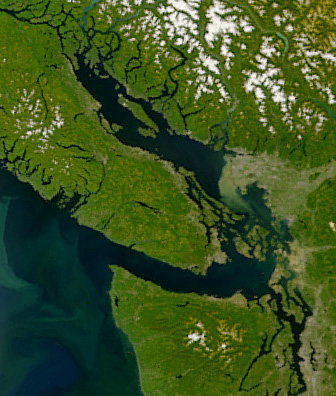 When I interviewed CBC Radio producer Paolo Pietropaolo back in January on the Inside Home Recording podcast, he talked about his upcoming documentary on the Salish Sea here in British Columbia.
When I interviewed CBC Radio producer Paolo Pietropaolo back in January on the Inside Home Recording podcast, he talked about his upcoming documentary on the Salish Sea here in British Columbia.
The original version appeared in the spring, and a documentary edition was broadcast this morning on the Canada-wide radio show "The Current." You can listen to both. They might work best in headphones, even though they weren't broadcast in stereo.
Labels: canada, cbc, environment, history, oceans, radio, seattle, vancouver
31 October 2009
Links of interest (2009-10-31):

- The rotor on the new Grouse Mountain wind turbine is turning very slowly, first time I've seen it move. Must be testing.
- Notice that when they have all those many layers on, supermodels almost look like normal people?
- Sydney, Australia covered the road of the Harbour Bridge with grass and cows, and 6000 people had a picnic.
- "No child has been poisoned by a stranger's goodies on Halloween, ever, as far as we can determine."
- Brent Simmons on vaccines (via Daring Fireball). I had chicken pox almost as bad, but at 15. My wife Air got shingles in '04. I'm flad the kids will get neither.
- If, like many Canadians, you have a huge voice crush on Nora Young, then this audio from CBC's Spark will slay you.
- Awesome song flowcharts for "Total Eclipse of the Heart" and "Hey Jude."
- Dan Savage is always so cheecky: "I don't believe that couples who make the choice to be monogamous should be discriminated against in any way."
- Archaeology doc "The Link" a few months ago was full of needless hype. Discovery Channel's "Discovering Ardi" shows how it's done properly.
- "I'm all for winging it, but saying 'I'm not really prepared' to an audience shows them the ultimate disrespect."
- Some interesting iPhone photography apps.
- Dark areas on this world map are the most remote from a city. No Antarctica, though.
- A new deal today with the Cowichan band means you'll be able to buy real sweaters at HBC Olympic store.
- Twelve images showing how vastly digital imaging has improved astrophotography on the ground and in space since 1974.
- Seven questions that keep physicists awake at night (still lots to learn, which is great).
- First-ever Lip Gloss and Laptops video podcast (for Halloween).
- American Samoa could have had a tsunami warning system, but funds were frozen in 2007 because of waste and corruption.
- Telus is selling iPhones in Canada Thursday of this week (Nov 5). Pricing is basically the same as Rogers/Fido (no surprise).
- The opposing Canadian "No TV Tax" vs. "Local TV Matters" ads are indistinguishable, obnoxious, and make both sides look like shitheads. Makes me want to go out and get some man-on-the-street interviews. "Excuse me, ma'am, did you know that both the TV networks and the cable companies are wasting money on advertising instead of trying to make better programming, using fake man-on-the-street interviews to try to confuse you about their own pissing contest? What do you think of that?"
- Here's a flu primer. The October 25 edition of CBC's "Cross Country Checkup" (MP3) is also good. Here's a slightly contrary position, and a more general one about the dangers of not vaccinating. Wired also has a cover story on the topic.
- Weird Al's relentless perfectionism in the studio (love when he gets a headache trying to channel Zack de le Rocha).
- As of today it's been 32 years since the last case of smallpox in the world was eliminated by vaccination.
- The 27" iMac has a shockingly low price for what you get - even for the LCD panel alone (via Dave Winer).
- Dave Winer also notes why death of a parent can make you grown up. My parents are alive, and doing great (better than me!).
- I like Barbara Ehrenreich's new book, though I haven't read it yet.
- Two people I know both had cancer surgery the same day, this past Monday.
- Top 10 Internet rules (via Raincoaster).
- $400 is expensive, but if you make serious video with a DSLR, I bet this LCD viewfinder is worth it (via Scott Bourne).
- Having to medivac a sailor from a US Navy submarine to a helicopter offshore is hairy and dangerous business!
- As Paul Thurrott said, people are going to be wandering into Microsoft's new store all the time and asking, "Excuse me, where are the iPods?"
- "If what you're doing does make sense, then, for Christ's sake, talk like a human being."
- From Psychology Today in 2008, ten ways we get the odds wrong on risk.
- You can now buy the whole Abbey Road album for Beatles Rock Band.
- Daughter M just described a fever-induced time dilation hallucination identical to mine from childhood. Never thought anyone would understand!
- Red Javelin Communications is apparently working with my company Navarik, but I'm finding their website rather too buzzwordy for my taste.
- Research in Motion. Oh, what will we do with you and your fine, fine, not-at-all-dirty URL http://rim.jobs?
- A great (much improved) update by Billy Wilson to my very popular "All the Current DLSRs" camera collage.
- Here's a sign of flu in our neighbourhood: our local Shoppers Drug Mart was entirely sold out of hand sanitizer. Both my kids were stricken, but I avoided it.
- Noya sings with my band sometimes. Here's her solo video.
- Another Ralph Lauren Photoshop disaster.
- The Diamond Dave Soundboard is still genius.
- As always, Saturn's rings and moons are some of the strangest and most beautiful things you can see.
Labels: australia, beatles, cbc, environment, evolution, holiday, lipglossandlaptops, microsoft, photography, podcast, sex, vancouver, video
15 October 2009
Sinking feeling
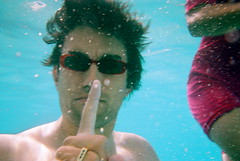 Today, as part of Blog Action Day, I've agreed to write about the environment and climate change. I've done that here many times before, generally in a positive way, or at least a frustrated one. But not today.
Today, as part of Blog Action Day, I've agreed to write about the environment and climate change. I've done that here many times before, generally in a positive way, or at least a frustrated one. But not today.
Maybe I'm just in a pessimistic mood, but honestly, I'm starting to think we're screwed. There are honest moves afoot, especially in Europe, to change patterns of human energy consumption and reduce carbon emissions. But here in North America, where we use more energy per person than all but a few very small countries, we're doing essentially nothing.
I first became aware of increasing human effects on the Earth's climate around Earth Day in 1990, almost 20 years ago, which was a pretty high-profile event. For awhile after that, there were lots of recycled products in the grocery stores, and talk of converting away from oil, gas, and coal to heat our houses, generate our electricity, and power our vehicles.
And then things slid back roughly to where they were before. Paper towels and toilet paper went from recycled brown to bleached white again. As the economy boomed, people who never went off-road or hauled lumber bought huge Hummers and pickup trucks. Politicians, businesspeople, activists, and others expended a lot of words about the problem of climate change. Yet here in Canada, while we've improved the efficiency of what we do, our overall emissions keep going up, despite our promises.
In the United States and Canada, we're distracted by economic crises and healthcare reform and celebrity scandals and cable reality shows. The developing world is growing too fast not to increase their own emissions. Europe and other countries making efforts aren't enough. By the time sea levels start rising in earnest and the social and political disruptions start, we probably won't be able to keep climates from changing all around the world.
So in all likelihood, we'll wait too long, and we'll have to adapt as our environment alters wildly around us. That will be expensive, disruptive, and probably bloody in all sorts of ways.
I'm not saying we should give up and do nothing, but right now it seems that, collectively, we (and I'm fully including myself here) are very nearly doing nothing by default. Since I have cancer, I don't know if I'll be around to see what happens in a few decades. But my kids will. They will most probably, as the curse goes, live in interesting times.
Labels: americas, blog, canada, environment, linkbait, news, politics
14 October 2009
iPods across oceans and continents
When we sold our old laptop recently, we used the money to buy a couple of iPod touches for our kids. I know, we spoil them terribly and all that. Ours is a geek house. Get used to it. (And if you're interested in their old iPod nanos, those are for sale too—let me know.)
Ordering online, I presumed (naively) that while the iPods are of course made in China, there would probably be a North American distribution centre where they are individually laser engraved and then shipped to customers here. But Apple and UPS let you track your order. Ours shipped directly out of China, and the results are a bit depressing.
There's been a lot of hoopla about Apple pulling out of the U.S. Chamber of Commerce over the Chamber's poor climate-change policies, Apple's greener laptops made with more recyclable materials, and so on, but I have to wonder whether many of those efforts are being negated by the insanely inefficient transport routes taken by items shipped from the online Apple Store.
Although I ordered two identical devices (with separate custom engraving on the back of each) at the same time, as part of the same order, here's how the two iPods are getting to our house:
- iPod #1: Shanghai, China → Anchorage, Alaska → Louisville, Kentucky → Buffalo, New York → Mount Hope, Ontario → Winnipeg, Manitoba → Calgary, Alberta → Richmond, B.C. → Burnaby, B.C.
- iPod #2: Shanghai, China → Anchorage, Alaska → Louisville, Kentucky → Lachine, Québec → Montréal, Québec → Mount Hope, Ontario → Calgary, Alberta → Richmond, B.C. → Burnaby, B.C
Same order, same type of device, same factory. But apparently, the most cost-effective way to get them to me was to send them together from Shanghai to Anchorage to Louisville, then to separate them, sending one via New York, Ontario, Manitoba, and Alberta, and the other via Québec, Ontario, and Alberta. Both passed through Mount Hope and Calgary, but at different times. They're both now in Richmond on the way here to Burnaby, hopefully on the same truck (but I'm not sure of that—see below for an unimpressive update).
It's about 9,000 km direct from Shanghai to Vancouver by plane, but on these routes each iPod has traveled almost twice that far (around 17,000 km) by plane and truck, with takeoffs, landings, and transfers. I know the packages are small, but the price of shipping that way can't possibly be taking into account the relative energetic and environmental costs of the two routes.
Never mind that, by essentially excluding environmental effects, it's less expensive to manufacture the iPods an ocean away to start with. How do these transactions add up, when you multiply them by the millions?
If we're interested in ameliorating climate change, I think that we'll have to address the mismatch between the monetary efficiency and energetic inefficiency of these haphazard transportation methods. But that will likely mean that our gadgets will get more expensive in the short term, in order to make our lives more tolerable in the long term. I have a feeling that, with our generally shortsighted human thinking, we might not be willing to accept that.
And that's a bit of a bummer.
UPDATE 11:30 a.m.: There's something amusing about the situation now. Both iPods arrived at Vancouver International Airport in Richmond before sunrise this morning, after making their way halfway around the world, rapid-fire, in five days. But they've now, apparently, been sitting at YVR, about 12 km away from my house, for three and a half hours without being loaded on a truck, because of "adverse weather conditions." What are those conditions? It's raining a bit. In Vancouver, in the autumn.
FURTHER UPDATE 2:00 p.m.: Delivery. Of one of the iPods. They were both at the airport, both supposedly delayed by weather (though it's sunny now), and one got put on a truck and arrived at the house a few minutes ago. The other one, presumably, is coming on another truck. Point reinforced. Next time I'll buy retail, where I can at least assume that two of the same product from the same batch came to the store in the same vehicle.
FINAL UPDATE 5:00 p.m.: The delay of the second shipment at YVR is a mystery even to the friendly UPS phone rep. It will be delivered tomorrow, taking longer to travel the 12 km from the airport to my house than it did to traverse the 3500 km from Ontario to the West Coast yesterday.
Labels: apple, china, environment, ipod, transportation, vancouver
13 May 2009
B.C. voters prefer the lame status quo
The BC Liberals won the British Columbia election again last night, as I expected. B.C. citizens gave them basically the same proportion of the vote and a slightly larger percentage of seats in the Legislature. Much more depressingly, voter turnout was yet again lower and BC-STV was resoundingly defeated. That's over. We're back with what we had before.
The BC Liberals are not my preferred choice, but they are at least tolerably competent in many respects. I guess I can live with that. However, the STV referendum gave us the chance to make our provincial government more representative and more interesting in the future, and we British Columbians turned it down.
My gut reaction is that yesterday, we B.C. voters were, on balance, lazy and chickenshit. That half of eligible voters didn't even bother, and that of those who did, a significant majority thought our current skewed system is just fine—well, that chafes.
I don't know if the numbers bear it out, but to me it feels like more people cared about how the Canucks did in the hockey playoffs than about deciding on the people we pay to respond to climate change, or to combat poverty, or to run the bloody province. And that we'll will bitch and complain about roads or homelessness or white-elephant megaprojects or the Olympics or cronyism and then not even vote when we get the chance.
On the bright side, perhaps the Liberals will be emboldened by a third straight victory to go beyond baby steps in their environmental policy. Maybe they can take a real lead in Canada on that most important of issues. They have a mandate to. I'm not optimistic, but I hope they run with it.
Labels: canada, environment, history, politics
01 May 2009
Canada's asbestos problem
 Mine is a pretty sensible country, just like our stereotype, but not always. A key example is our bizarre asbestos industry.
Mine is a pretty sensible country, just like our stereotype, but not always. A key example is our bizarre asbestos industry.
Asbestos is nasty shit: "All forms of asbestos," says Leslie Stayner, director of epidemiology and biostatistics at the University of Illinois School of Public Health, "cause both mesothelioma and lung cancer." Anytime asbestos is discovered in old construction here in Canada, the location is shut down for thorough removal of the mineral. Numerous countries around the world have banned use of the substance outright.
Yet in a few Quebec towns, asbestos mining continues, supporting about 500 jobs and bringing in about $100 million a year. (My wife visited one of those towns, Thetford Mines, on a French exchange when she was a kid and the industry was larger.) Since it's illegal to use here, our asbestos gets shipped overseas, to India, Indonesia, Thailand, and elsewhere where it's still permitted. There, it presumably kills people by giving them cancer.
The puzzling thing is that the Canadian government acts like it's still the 1940s, arguing that the form of asbestos we mine and sell, called chrysotile, can be handled and used safely. Perhaps it can, though it seems unlikely—plus I highly doubt construction projects in developing countries do so anyway.
Even our erudite new Leader of the Opposition, Michael Ignatieff, seems to have been cowed by the asbestos lobby, moving from a strong anti-asbestos position a couple of months ago to a "we need more research" stance. Yet we've known for decades that the stuff is a substantial, carcinogenic health hazard in all its forms.
It's sad to say, but if Canada's asbestos industry were anywhere other than Quebec, it probably would have shut down years ago, especially since it is now such a small part of our economy. Continued support from our two major federal parties, the Liberals and the Conservatives, seems to me a cynical political move, to avoid offending Quebec nationalists and the chrysotile lobby based in that province.
So one of our long-simmering domestic political quagmires keeps us selling a toxic mineral to the developing world. Not very sensible.
Labels: canada, cancer, controversy, environment, linkbait, politics
23 April 2009
Videos that are scary-dumb
Example the First: I stumbled into this fine satire of a climate change denial video the other day. It's hilarious, with its ironic attempts at hipness, images of the world exploding, and with-it clip art youth proclaiming "Shut up!", "What the hell?", and "No way!"
Except, um, it's not a satire. It's an actual, serious video from our pals here at Vancouver's right-wing think-tank the Fraser Institute. I think it may very well be the "Gathering Storm" of anti–global warming videos—so ridiculous it's laughable.
Example the Second: Via Phil Plait, I found this astonishing record of Texas congressman Joe Barton, yesterday asking the U.S. Secretary of Energy Steven Chu (also the winner of a Nobel Prize in Physics, by the way) where all the oil in Alaska came from. Chu is obviously puzzled at why Barton would ask something so basic, but as the congressman continues his question, Dr. Chu realizes that Mr. Barton apparently doesn't have the first clue about geology or plate tectonics:
Wow. Even more depressing, Mr. Barton thought he'd stumped Dr. Chu, and said so on his Twitter account! The rest of the Twitterverse (me included) quickly corrected the congressman. Since Dr. Chu only had six seconds to respond, and was obviously so aghast at Mr. Barton's lack of knowledge, he couldn't formulate a proper response. Given a minute, he could have said:
Hundreds of millions of years ago, when Alaska was in a different place on the globe because of continental drift, trillions of microorganisms lived and died there. Immense heat and pressure converted their bodies, buried deep underground by geological processes, into simpler hydrocarbons, like oil. That’s why they’re called fossil fuels.
Not an Example: As a relief from those, here's something amazing (via Tim Bray and kk+):
That's more like it.
Labels: bicycle, environment, extremesports, science, video
22 April 2009
Morbid linkage on Earth Day
 I don't scour the Web for cancer news. Having cancer myself means the topic is enough on my mind already without reading too much more about it, and I don't seem to be the type to leap wholeheartedly into cancer advocacy as some do. Yet interesting stuff still comes my way.
I don't scour the Web for cancer news. Having cancer myself means the topic is enough on my mind already without reading too much more about it, and I don't seem to be the type to leap wholeheartedly into cancer advocacy as some do. Yet interesting stuff still comes my way.
It's also easier to read that stuff since my last CT scan was more encouraging than usual—even if today I'm having a worse-than-usual bout of side effects from my medication. I've been sitting on our recliner couch most of the day, and have to stay close to the bathroom all the time. (Hey, minimal carbon footprint!) So, some of my reading today:
- First, my friend Alistair sent a link to this comic, which reinforces that "curing cancer" isn't a realistic goal, because cancer isn't one simple thing. It's a bit of a bummer, really, but also a good reality check.
- Speaking of bummers, this series of photos (via Kottke) of a young cancer patient who kept herself going so she could get married to her high school sweetheart, but died five days later, is wonderful. Tremendously sad, yet uplifting too.
- I know this is a Big Pharma ad, but the Pfizer "Be Brave" commercial slays me every time.
- A couple of years ago, when I thought I might die soon, I posted about what I'd like to happen to my body once I'm dead. Now, I seem to be carrying on, but that stuff is still worth considering for anyone, and I discovered recently that it's surprisingly easy to donate your body for anatomical study and medical research at my alma mater, UBC. They even have a consent form to download right from the site. Unfortunately, "advanced metastatic cancers" may prevent a body from being useful for what they need, so that's a bit annoying. Maybe donating just my skeleton somewhere would be better. Fortunately, it looks like I have some time to investigate this stuff now...
- My Flickr pal e_hoogie has a rare genetic condition that makes her prone to all sorts of different cancers, and she's been treated for five different kinds, but she's still going, five years later. Inspiring.
As for me, I expect the side effects to calm down this afternoon or evening. I may go take some pictures in the yard right now. Maybe tomorrow I can get out and snap some more in the sun, and then go see one of my daughters read at her school for literacy week.
This is my third spring with cancer, and I'm glad to see it. Here's hoping for a bunch more.
Labels: cancer, chemotherapy, environment, photography, science, television
20 April 2009
Win $155 worth of Aveda body products from my wife's podcast
My wife's podcast Lip Gloss and Laptops is giving away two $155 Aveda Earth Day gift packs of various cosmetics and body products. The draw is open to Canadian residents only, and you have to enter by the end of Earth Day, Wednesday, April 22, 2009. If it sounds like your kind of thing, the details are over at the LGL site.
What's the Earth Day connection? I haven't read the press info for the bundle, but I can tell you that the packaging is definitely green in colour, and you get a really sturdy canvas shopping bag if you win too.
Incidentally, I've never known how to say Aveda (or AVEDA, as they sometimes capitalize it). Ah-VEE-dah? Ah-VEY-da? AH-ve-dah? Anyone know?
Labels: contest, environment, lipglossandlaptops, podcast
09 March 2009
Excuse me?
I looked out the window this morning and I was actually angry. I don't anger easily, but here's the view now, after I shoveled the walk and driveway and cleared off the car:
This is Vancouver. In March. In contrast, here's what we were doing in your yard in February last year:
Or, for that matter, three weeks ago at the schoolyard:
Even my kids looked out at the snow today and said, "Not again!"
I mean, WTF?
Labels: annoyances, environment, snow, vancouver, weather
16 October 2008
Links of interest (2008-10-16):
I'm still doped up on Tylenol 3's and pretty tired post-surgery, so am not up for much thinking or original posts. I'm also contemplating email bankrupcy again, mere months after my last one, as my inbox creeps up to 800 once more. Sigh. Anyway, here's some interesting stuff:
- What if all movies had cell phones? (There's a good reason No Country for Old Men was set in 1980, by the way.)
- A worthy quote in this electional season: "I like to pay taxes. With them I buy civilization." - Oliver Wendell Holmes (though it may be a folksier recasting of "Taxes are the price we pay for a civilized society").
- "Hey news executives! Try this newsroom pop quiz: Give each staff member a pencil and tell everyone to stop what they're doing and write out the tag that creates a hypertext link." (via Dan)
- Andrew Sullivan rounds up quotes from a number of last night's press and blogger reactions to the final McCain-Obama debate.
- Also from Sullivan, it's a bit sad how well this video reflects the approach of the McCain campaign right now.
- While Leica's upcoming S2 camera is quite large (especially the lenses) for a digital SLR, it has a medium-format size sensor, meaning that it is smaller and probably more ergonomic than most of its direct competitors, and that even the rumoured €10,000–20,000 price isn't as insane as it sounds. Nevertheless, the cost of a reasonably complete S2 system when it's released next year will rival that of a condominium. It also bodes well for future "lower end" (for Leica, at least) cameras from this legendary manufacturer.
- What's it like to write other people's term papers for a living? (via Kottke)
- The web comic Basic Instructions makes me laugh almost every single time a new one comes out.
- Vancouver locals Buzz Bishop and Darren Barefoot accurately summarize the Canadian election held this week, in which nothing much changed. The result (as I discussed earlier) bodes poorly for our country's environmental and climate policy, which is one subject we can't afford to waste time on, unfortunately.
Labels: environment, film, leica, linksofinterest, movie, news, photography, politics, school, telecommunications, web, writing
05 October 2008
How left-wing Canada elects a right-wing government
We Canadians are having an election too, on October 14, a few weeks before our southern neighbours in the U.S.A. By the standards of most countries in the world, Canada's political climate is a social democratic one, particularly on social and moral issues. (By the somewhat skewed perspective of modern American politics, therefore, we probably all seem like we're Shining Path guerrillas.) In the last election in 2006, about 36% of the population voted for the Conservatives, the centre-right party that currently forms a minority government in Parliament.
What it means is that even when we elected a conservative (for us) government, 64% of Canadians still voted for parties more left-wing than that, from the centre-left Liberals to the democratic socialist New Democratic Party (NDP). Even the Bloc Québecois, whose primary platform is Québec independence (or sovereignty, in Canadian politispeak) are left-leaning in their other policies, while the environment-angled Green Party—a more significant force in 2008 than two years ago—is conservationist, rather than conservative.
Hidden coalitions
Unlike many other democracies, especially those with proportional representation systems that our British-style parliamentary system lacks, Canada really doesn't favour formal multi-party coalition governments. However, we often get them, in effect, by other means. That occurs when several left- or right-leaning parties merge to regain power after living in a vote-splitting wilderness for a few years.
I recall, for example, the early-’90s era when the federal Reform and Progressive Conservative ("Tory") parties split the vote on the right, so that even with the Bloc dominating in Quebec, the Liberals maintained power for a decade by winning a majority of seats elsewhere. At the same time, provincially here in British Columbia, the formerly dominant Social Credit Party, B.C. Reform (a brief experiment), and the Liberals all divided the centre-right and right vote, keeping the provincial NDP in power over a couple of election cycles.
Those situations ended a few years later when, respectively, Reform and the Tories merged into the current Canadian federal Conservative Party, and the various centre-right and right-wing parties in B.C. coalesced around the B.C. Liberals, who form our current provincial government. But that situation also ensures that no elected party can become too extreme: in the Conservative Party, for example, the far-right social conservatives (many of whom used to belong to the Reform Party) form only a fraction of the government's caucus, and if they tried to impose their views on the legislature as a whole, they could generate another schism that loses them the next election.
Flipping the split
And so we have a governing party whose members often disagree profoundly with many of the laws over which they preside. This is a country of legalized gay marriage, socialized medicine, no restrictions on abortion, minimal overt religious influence over politics, wealth redistribution among the provinces by the federal bureaucracy, institutionalized bilingualism and multiculturalism, and one of the larger immigration rates in the developed world. Yet our Conservative government dares not alter those tenets in any fundamental way.
Unfortunately for lefties like me, however, in this federal election it is the left wing that is split, among the NDP, Greens, Bloc, and Liberals. That is unusual in Canadian history—the Liberals are frequently nicknamed our "natural governing party" because they have won so often overall. But as further evidence of a general left-wing bias in the Canadian electorate, the left has always been split since the rise of the NDP and its predecessor the Cooperative Commonwealth Federation (CCF) more than 60 years ago, and yet the centre-left Liberals have still been in power most of that time. However, in the 2008 election, the wider left split may have particularly dire, long-term real-world consequences.
The Conservatives are likely to win again, perhaps with a majority instead of a minority of seats in Parliament, but with only a minority of the overall vote. In general I could live with that. But critically, while the more socially regressive ideas of Prime Minister Stephen Harper (a former Reform Party MP) are reined in by his party's "big tent," his government is the worst option on environmental issues. Only the Liberals—not even the Greens!—have proposed a carbon tax, which I think will be necessary to shift our energy usage. But even that comes after more than ten years of inaction on climate change when it counted most, when the Liberals were actually in power in the '90s and early 2000s.
Strategy and environment
With our non-proportional parliamentary system, many Canadians vote strategically. I cast my ballot in the advance poll this weekend, but I’m in a bit of an unusual situation, living in the Burnaby-Douglas riding long represented by the NDP’s Svend Robinson and, since his theft-related retirement, by his former assistant Bill Siksay. Both have been heavily involved in the local community, outspoken in Parliament (Svend notoriously so), and elemental in their party’s platform decisions.
Voting NDP has been an easy choice for me ever since I became eligible 20 years ago in this riding—I know my vote is not “wasted” (NDP founder Tommy Douglas was an MP here too at one point, so his party has always been a strong contender), and as a lefty I agree with the party platform on many issues. Were I in a different riding, I might vote more strategically, choosing Green or Liberal. As it is, my decision was simple, because my riding and national interests align.
Yet because of our current political morass, I think we stand to make poor national policy decisions on climate change, when time is running short to make the right ones.
Labels: canada, environment, politics, vancouver
12 September 2008
Indian Arm
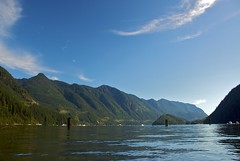 Indian Arm is a forbidding, steep-sided wild fjord, which is nothing unusual on the British Columbia coast. What is unusual is that I can see it (or at least the mountains that surround it) from my front window. Mere minutes from Vancouver's urban sprawl, the waters of the Arm are frequented by boaters of all sorts—but the slopes rising from its shores are too steep and rugged, and almost no one ever traverses them.
Indian Arm is a forbidding, steep-sided wild fjord, which is nothing unusual on the British Columbia coast. What is unusual is that I can see it (or at least the mountains that surround it) from my front window. Mere minutes from Vancouver's urban sprawl, the waters of the Arm are frequented by boaters of all sorts—but the slopes rising from its shores are too steep and rugged, and almost no one ever traverses them.
Back in 2003, engineer, rock climber, and trailbuilder Don McPherson completed his project of many years: a trail around the entirety of Indian Arm. But it's no stroll, nor even a hike. The "trail" is really simply a route, a roughly marked, 70 km, four-day (minimum) slog up and down mountain ridges, along cliffs and valleys, and through thick forest. The elevation map is insane. McPherson himself writes:
Traveling the easy way is a 16,500 ft (5500 m) elevation gain, and nearly a 20,000 ft descent. A climbing rope and the knowledge of how to use it should be included in your 35-50+ lb pack. I do not recommend this route to anyone.
There's an endorsement. His "easy way" (from west to east) starts 1000 metres up Seymour Mountain (there's a parking lot for the ski area), ascends to near its summit, and then follows the alpine ridgeline of the mountain range behind. All that climbing and dropping means that, if you walked the whole route, you would ascend and descend as far as if you were climbing 14,000 ft Mt. Rainier in Washington.
I will never hike that trail, which is one reason it fascinates me. Years ago, I rode a mountain bike route along logging roads from Squamish to Indian Arm, which ended at the fjord's northern tip. But we had booked a water taxi to return us to Vancouver, because McPherson's crazy trail would have been the only path directly back, even if it had been finished back then. There has never been a road, and probably never will be.
Vancouver is a substantial city, but we have always been a city at the edge. To the west lies Georgia Straight, then the Pacific Ocean. To the east and north, craggy and glaciated mountains as rough as anywhere. Indian Arm makes sure we don't forget it.
Labels: environment, extremesports, park, vancouver
01 September 2008
Links of interest (2008-09-01):
- It's a fact: I find it astonishing that the governor of Alaska (Alaska!), and new vice-presidential running mate for John McCain, doesn't think that climate change is human-generated. I'm guessing her house isn't built on melting permafrost.
- I'll let Dan Savage give his trademark trenchant take on the other Sarah Palin news.
- This past week Canon introduced its new EOS 50D SLR (a nice upgrade from the 40D), and Nikon followed with its D90 (which supersedes the D80 and takes movies, a first for an SLR camera). While I use Nikon myself, and the D90 would be great if I needed a new camera, for people just getting into the market, I still think the Pentax K200D is an excellent deal.
- Speaking of photography, the always-snarky Ken Rockwell has (as usual) excellent advice on how to carry less stuff so you make better pictures. I should have heeded his advice when I went up Whistler mountain a few weeks ago. I took a bunch of photos, but only used one lens, even though I schlepped a whole bag's worth of stuff (plus a tripod I never unfolded) up there—just like the guys Ken was making fun of at the zoo.
- I'm a little too old to have ever been all that interested in going to Burning Man, but I'm particularly glad to have avoided this year's dust storm. Yuck.
- Looks like Americans won't be the only ones having an election this fall.
Labels: canon, environment, linksofinterest, nikon, pentax, photography, politics
10 May 2008
Volcano and thunderstorm
Via Kottke, here is a gallery of UPI photos of a thunderstorm meeting the volcanic plume from the Chaitén volcano in Chile this week. Check out picture #11:
Whoa, as Keanu would say. I never knew the Spanish term for thunderstorm before, but it's pretty nifty: tormenta eléctrica.
Labels: americas, disaster, environment, news, photography, science
22 April 2008
Burnaby's birds, beavers, bogs, and boats
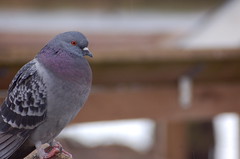 The city of Burnaby, B.C., where I grew up and live, is just to the east of Vancouver itself, and is well known for a significant amount of parks and other green space for such an urban environment. One part of that is Burnaby Lake, a fairly large and extremely shallow wetland in the centre of the municipality.
The city of Burnaby, B.C., where I grew up and live, is just to the east of Vancouver itself, and is well known for a significant amount of parks and other green space for such an urban environment. One part of that is Burnaby Lake, a fairly large and extremely shallow wetland in the centre of the municipality.
The lake sits in Burnaby's central valley, and forms part of a waterway that starts at Trout Lake in Vancouver, runs east along Still Creek through Burnaby into the lake, and out into the Brunette River, which flows east and then south through Coquitlam into the Fraser River, which empties westward into the ocean. In recent decades governments have dredged the lake several times, both to provide enough depth for competitive rowing and to avoid having excessive sediment from development and the city's storm sewer system turn the lake into a mudflat—which is why the water's edge is so sharp in the satellite photo.
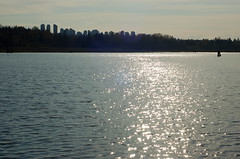 My wife had the great idea of taking the kids on a ten-minute car ride down the hill from our house every few days to check out the waterfowl and other birds, and to see if any chicks have arrived yet this spring. So far they haven't. But there are tons of animals and plants there, from birds such as ducks, Canada geese, crows, and pigeons to carp, frogs, squirrels, and even a significant population of beavers, the world's largest rodent and Canada's mascot.
My wife had the great idea of taking the kids on a ten-minute car ride down the hill from our house every few days to check out the waterfowl and other birds, and to see if any chicks have arrived yet this spring. So far they haven't. But there are tons of animals and plants there, from birds such as ducks, Canada geese, crows, and pigeons to carp, frogs, squirrels, and even a significant population of beavers, the world's largest rodent and Canada's mascot.
She's gone down there with them a bunch of times, but this weekend I was feeling well enough to tag along. And a couple of days ago the sunny weather and abundant animals brought out another example of local wildlife: the Canadian wildlife photographer, whose distinctive plumage and plaintive ktsch-ktsch-ktsch-ktch call (known affectionately as the "shutter-and-mirror-slap") were in fine form down at the Piper Spit pier. The next day we visited again (this time one of the girls' school friends joined us), but our bunch was alone because of the cold and rain, which actually turned to snow briefly.
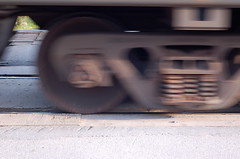 The entrance to that part of the park also crosses some railway tracks, which our daughters enjoy putting pennies on to see if they'll be flattened by passing trains. We're accumulating quite a collection of thin copper ovals now.
The entrance to that part of the park also crosses some railway tracks, which our daughters enjoy putting pennies on to see if they'll be flattened by passing trains. We're accumulating quite a collection of thin copper ovals now.
Exactly 20 years ago, in April 1988, I was working a summer job as a park naturalist, headquartered at the nature house at this exact spot, between the railway and the boardwalk. That job was where my wife and I first met. We led canoe tours of the lake some evenings (no motor craft allowed), and this year we're thinking of getting a canoe and taking our kids out there too.
Labels: anniversary, environment, family, friends, love, memories, park, vancouver
16 April 2008
The Vancouver light
I finally saw Juno tonight. My kids and I watched it on DVD together. Yes, it's a very good movie. You can read the reviews for that.
As somebody who lives in Vancouver, what I really noticed was how obviously Vancouver it is. You can see it in the locations—the residential architecture and subdivisions, the trees and lawns, and especially the light. As in so many things filmed here, like The X-Files and everything else, the light is different from what you see in productions filmed in Los Angeles, New York, Toronto, or other film centres.
It must be the combination of our latitude, weather, proximity to the sea—cloudy or sunny, rain or snow—it looks like here. Maybe Seattle might look similar, yet somehow things filmed there don't look the same.
Does anyone have a line on why that might be?
Labels: environment, film, photography, seattle, vancouver
15 April 2008
After a year and a half, Stanley Park surprised me
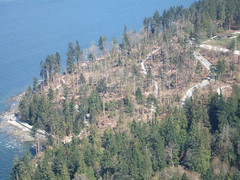 With all my cancer treatments and so on, I have, remarkably, not been to Vancouver's famous Stanley Park since the vicious windstorm that hit Greater Vancouver near the end of 2006, a year and a half ago.
With all my cancer treatments and so on, I have, remarkably, not been to Vancouver's famous Stanley Park since the vicious windstorm that hit Greater Vancouver near the end of 2006, a year and a half ago.
Having been born and raised in this city, I think that's the longest time I've ever been away from the park in my entire life, until today. I was downtown for an errand, and decided to take a side trip in the car to drive through the park and see how things were going.
I was astonished. Toppled trees are still everywhere, and the stretch of Park Drive from Prospect Point to Third Beach is unrecognizable. What I always knew as a dense rainforest overhanging the road now comprises steep, open vistas across hundreds of broken trunks down to the ocean.
Rebecca at Miss604.com has been documenting the changes since the storm hit, so I had some idea what to expect—but not really. I'd like to take my bike down there sometime in the next few months and explore the trails again. In many ways, it's a whole different place now.
Labels: environment, history, park, vancouver, weather
07 April 2008
Lovely aerial night city photos from Doc Searls
Check out this beautiful set of pictures of city lights from Doc Searls. He took them while flying on a commercial jet up the U.S. East Coast:
It's a shame that we waste so much energy radiating light out into space, but it's pretty.
Labels: airport, art, canon, docsearls, environment, flickr, photography
02 April 2008
Did humans kill off the woolly mammoth?
 There's long been speculation that as humans moved into Arctic territories (as well as into North America), we were primarily responsible for the extinction of the woolly mammoth about 12,000 years ago. Other researchers have favoured climate change at the end of the Pleistocene era as the main reason they disappeared.
There's long been speculation that as humans moved into Arctic territories (as well as into North America), we were primarily responsible for the extinction of the woolly mammoth about 12,000 years ago. Other researchers have favoured climate change at the end of the Pleistocene era as the main reason they disappeared.
New research indicates that, in Eurasia at least, the answer is probably both. Mammoth populations fluctuated hugely throughout the Pleistocene, dropping to levels even lower than their pre–human contact point as much as 125,000 years ago, during a warming period.
But when humans entered the picture millennia after that, as the Ice Age glaciers were melting, mammoth populations were again low, and our hunting activity likely slowly picked the big pachyderms off.
The last woolly mammoths to die off were amazingly recent: a dwarf variety survived until less than 4,000 years ago on Wrangel Island, in the Arctic Ocean off the desolate far northeast coast of Siberia. That human hunting had a role in their demise is no surprise: quite often, when our species has moved into new areas (especially isolated ones), we exterminate species that live there, especially large yummy ones.
Maoris eliminated moas from New Zealand not long after arriving between 800 and 1300 A.D. (moas were gone by 1500, a couple of hundred years before Europeans started showing up). Similarly, dodos disappeared in the late 1600s after humans arrived on their home island of Mauritus. And we're doing an effective job of bringing a variety of big species, from blue whales to Siberian tigers—and many other organisms too—close to the vanishing point today. Only rarely, as in the case of the smallpox virus, do we do it on purpose.
It's possible that woolly mammoths might have disappeared even without us as the Ice Age ended. But we very likely speeded their extinction along.
Labels: environment, evolution, history, science
30 January 2008
Links of interest (2008-01-30):
A bunch of stuff I've been accumulating over the past few months:
- Types of coffee beverages
- U.S. regional pizza styles
- Build your own Apple Store
- Google Maps mashup of how Greater Vancouver would be flooded by a 4-metre sea level rise (move around to check out your own area nearly anywhere in the world)
- J Allard's thoughts on the first year of the Zune
- Very useful Cascading Style Sheets (CSS) reference for web developers
- How well does restoring from Apple's new Time Machine backup work?
- Intro to Fully Flared features slo-mo skateboarding, explosions
- When you post to your blog, where does the information go?
- Tips to give presentations more like Steve Jobs
- What other sites are on your shared web server?
- How Microsoft would reveal it hasn't done its homework in school (see?)
- New Apple instructional videos
- Long Radiohead video that features all the songs on In Rainbows
Labels: apple, backup, band, blog, environment, extremesports, food, google, linksofinterest, macosx, microsoft, music, publicspeaking, web
03 December 2007
Most people have probably never seen snow
In a comment on one of my photos of the first real snowstorm of the season yesterday (it's almost all melted now, by the way), an Australian reader noted that he had never seen snow first-hand in his life.
That's a strange concept for any Canadian, but I started thinking about it and realized that not only did our hominid predecessors evolve in parts of Africa where it never snows, even today the great centres of human population—some of the most densely inhabited parts of China, the vast majority of India, Indonesia, almost all of Africa, the supercities of South America, and elsewhere—are also largely snow-free zones.
In other words, it has probably always been true that a big proportion, and likely the majority, of the human species has never experienced snow. And despite much easier travel, that is becoming more true as populations and climate shift. It's amazing that any number of us, from the Inuit, to the mountain dwellers of Peru and Afghanistan, to the bureaucrats in Ottawa, Vienna, and Ulan Bator, can handle the white stuff at all.
Does anyone have any data to back up my theory?
Labels: australia, environment, evolution, snow, travel, weather
23 November 2007
A whale straight in the eye
 Blue whales are so large that, in most oceans in the world, if you were underwater with an adult one, you wouldn't be able to see one end from the other.
Blue whales are so large that, in most oceans in the world, if you were underwater with an adult one, you wouldn't be able to see one end from the other.
If one were swimming in the nutrient-rich waters near Vancouver, for instance, the body of the whale would disappear into the distance because the visibility is too obscured (by plankton and other things in the water itself) to take in the animal's entire 30-metre length—about the same as three typical shipping containers.
But if you want to see what it would be like to examine a blue whale up close, life size, here's a web page (via Mirabilis) where you can do it.
Labels: animals, biology, environment, oceans
18 October 2007
Choices vs. guesses
More than five years ago I linked to an argument by Canadian conservative newspaper columnist Andrew Coyne favouring action on climate change. His argument, essentially, was that:
...the chances that the many distinguished scientists who predict an impending climatological catastrophe will prove to be right must be considerably greater than the chances I will be run over by a bus tomorrow. Or at any rate, they are greater than zero. In which case, would it not be prudent to take out some insurance against the event?
And that the costs of emissions reductions and alternative energy strategies are not (or at least, were not in 2002) out of line with what you would expect to pay for insurance on similar potential risks.
My cousin recently sent me a simple nine-minute YouTube video on climate change risks (not really the "most terrifying video you'll ever see," but hey). It makes a similar point, perhaps more clearly, or at least more visually, with nothing but a guy at a whiteboard:
It comes down to choices vs. guesses: we can choose to change our energy use and effects on the planet's climate, or we can guess that we don't really need to do that. The risk of guessing is much bigger than the risk of choosing.
Labels: controversy, environment, probability, science
10 October 2007
Greener future?
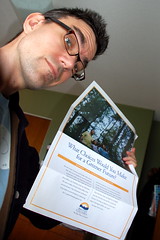 British Columbia's Liberal provincial government (not renowned for its environmental record) recently sent out a tabloid-sized, four-page flyer to B.C. residents. We received ours today. The title is "What Choices Would You Make for a Greener Future?: Budget 2008 Consultation Paper" (here's the PDF).
British Columbia's Liberal provincial government (not renowned for its environmental record) recently sent out a tabloid-sized, four-page flyer to B.C. residents. We received ours today. The title is "What Choices Would You Make for a Greener Future?: Budget 2008 Consultation Paper" (here's the PDF).
In essence, it asks us where we think the government should spend money to reduce greenhouse gas emissions, encourage alternative power sources and transportation options, pay for healthcare costs, and provide adequate housing for our fellow citizens.
There is an online version of the questionnaire, which is handy. Overall, it's an interesting and encouraging idea. But before even reading the flyer, I flipped it over and read the fine print:
Normally I would think it wise—indeed expected—for governments to use paper with a reasonable proportion of recycled pulp in it, and 40% isn't bad. But for a flyer talking about a "greener future," using 100% post-consumer recycled paper is the only reasonable choice. I wouldn't care if it was brown or grey rather than stark white.
As it is, the 40% recycled content (or rather, the 60% non-recycled content) makes the whole publication and the process behind it look like lip service to environmental causes. Gillian also notes that there's a whole stack of the flyers in her building's recycling bin next to the mailboxes—a stack that certainly never got read.
While I'm filling out the online questionnaire, I will be wondering where my opinions will be registered, and whether they'll end up 60% watered down as well. It's too bad I ended up thinking so cynically.
Labels: environment, government, green, science
